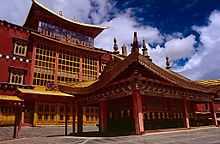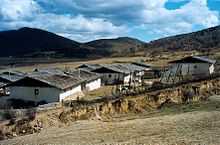Shangri-La County
| Shangri-la County Semkyi'nyida [1] / Xianggelila / Xamgyi'nyilha County སེམས་ཀྱི་ཉི་ཟླ་རྫོང་ 香格里拉县 | |
|---|---|
| County | |
 | |
.png) | |
 Shangri-La (Sem kyi nyida) | |
| Coordinates: 27°50′N 99°42′E / 27.833°N 99.700°E | |
| Country | People's Republic of China |
| Province | Yunnan |
| Prefecture | Dêqên |
| Area | |
| • Total | 11,613 km2 (4,484 sq mi) |
| Population | |
| • Total | 130,000 |
| • Density | 11/km2 (29/sq mi) |
| Time zone | China Standard (UTC+8) |
| Postal code | 674400 |
| Area code(s) | 0887 |
| Website | www.shangri-la.gov.cn |
| Shangri-La County | |||||||
| Chinese name | |||||||
|---|---|---|---|---|---|---|---|
| Simplified Chinese | 香格里拉县 | ||||||
| Traditional Chinese | 香格里拉縣 | ||||||
| |||||||
| Former Chinese names | |||||||
| Simplified Chinese | 中甸县 | ||||||
| Traditional Chinese | 中甸縣 | ||||||
| |||||||
| Tibetan name | |||||||
| Tibetan |
present: སེམས་ཀྱི་ཉི་ཟླ་རྫོང་ former: རྒྱལ་ཐང་རྫོང་ | ||||||
| |||||||
Shangri-La County (Tibetan: སེམས་ཀྱི་ཉི་ཟླ་རྫོང་, Wylie: sems kyi nyi zla rdzong, ZYPY: Sêmgyi' nyida, Chinese: 香格里拉县; pinyin: Xiānggélǐlā xiàn) is a primarily Tibetan county in northwestern Yunnan province, People's Republic of China and is the location of the seat of the Dêqên Tibetan Autonomous Prefecture.
Name
In the second half of the 20th century the county was called Zhongdian County (Chinese: 中甸县 Zhōngdiàn Xiàn) but was renamed in 2001 after the fictional land of Shangri-La in the 1933 James Hilton novel Lost Horizon, in an effort to promote tourism in the area. The original Tibetan population refers to this place by its traditional name Gyalthang (Standard Tibetan: རྒྱལ་ཐང་རྫོང་), meaning "Royal plains". This ancient name is reflected in the Tibetan Pinyin name Jiantang Town (建塘镇; Jiàntáng Zhèn), the county seat.
Towns
- Jiantang Town
- Zhongdian Town
- Hutiaoxia Town
- Jinjiang Town
- Luoji Township
In the early morning of January 11, 2014, a fire broke out in the 1,000 year old Dukezong Tibetan neighborhood. About 242 homes and shops were destroyed and 2,600 residents were displaced.[2]
Climate
Shangri-La has a monsoon-influenced humid continental climate (Köppen Dwb), due to the high elevation. Winters are chilly but sunny, with a January 24-hour average temperature of −3.2 °C (26.2 °F), while summers are cool, with a July 24-hour average temperature of 13.5 °C (56.3 °F), and feature frequent rain; more than 70% of the annual precipitation is delivered from June to September. The annual mean is 5.85 °C (42.5 °F). Except during the summer, nights are usually sharply cooler than the days. Despite the dryness of the winter, the small amount of precipitation is generally sufficient to cause major transportation dislocations and isolate the area between November and March.
| Climate data for Shangri-La (1971−2000) | |||||||||||||
|---|---|---|---|---|---|---|---|---|---|---|---|---|---|
| Month | Jan | Feb | Mar | Apr | May | Jun | Jul | Aug | Sep | Oct | Nov | Dec | Year |
| Record high °C (°F) | 18.3 (64.9) |
16.2 (61.2) |
21.5 (70.7) |
22.7 (72.9) |
24.2 (75.6) |
25.6 (78.1) |
25.4 (77.7) |
25.1 (77.2) |
23.8 (74.8) |
20.9 (69.6) |
18.8 (65.8) |
17.9 (64.2) |
25.6 (78.1) |
| Average high °C (°F) | 6.3 (43.3) |
6.7 (44.1) |
9.2 (48.6) |
12.5 (54.5) |
17.0 (62.6) |
19.2 (66.6) |
19.3 (66.7) |
18.9 (66) |
17.4 (63.3) |
14.7 (58.5) |
11.0 (51.8) |
8.2 (46.8) |
13.37 (56.07) |
| Average low °C (°F) | −11.2 (11.8) |
−7.4 (18.7) |
−3.6 (25.5) |
−0.5 (31.1) |
3.4 (38.1) |
8.4 (47.1) |
9.8 (49.6) |
9.1 (48.4) |
7.4 (45.3) |
1.3 (34.3) |
−5.8 (21.6) |
−10.6 (12.9) |
0.02 (32.03) |
| Record low °C (°F) | −23.9 (−11) |
−20.2 (−4.4) |
−17.5 (0.5) |
−10 (14) |
−7.4 (18.7) |
−2.1 (28.2) |
1.1 (34) |
1.0 (33.8) |
−3 (27) |
−11.1 (12) |
−16.5 (2.3) |
−27.4 (−17.3) |
−27.4 (−17.3) |
| Precipitation mm (inches) | 7.8 (0.307) |
14.4 (0.567) |
34.8 (1.37) |
32.4 (1.276) |
25.9 (1.02) |
80.2 (3.157) |
157.4 (6.197) |
151.3 (5.957) |
80.6 (3.173) |
44.5 (1.752) |
12.7 (0.5) |
4.9 (0.193) |
646.9 (25.469) |
| Avg. precipitation days (≥ 0.1 mm) | 4.2 | 6.6 | 9.3 | 11.1 | 11.5 | 17.9 | 23.2 | 23.1 | 19.3 | 10.1 | 4.0 | 2.1 | 142.4 |
| Source: Weather China | |||||||||||||
National park


- Pudacuo National Park, the first national park in China to meet IUCN standards, also incorporates the Three Parallel Rivers of Yunnan Protected Areas World Heritage Site.
Transport
- The town's airport is Diqing Airport. Covering an area of 225 hectares, it is one of the biggest airports in the northwest of Yunnan. There are flights to Kunming, Chengdu, Lhasa, Guangzhou and Shenzhen.
- Many travelers use the county town as a gateway into Tibet, either travelling many days overland by jeep to Lhasa, or by flying from the city's airport. However, the town itself is a tourist destination, primarily due to the nearby Gandan Sumtseling Monastery (དགའ་ལྡན་སུམ་རྩེན་གླིང་, Ganden Sumtsen Ling, 松赞林寺 Sōngzànlín Sì), Pudacuo National Park, and Tiger Leaping Gorge.
- China National Highway 214
See also
- Forbes, Andrew ; Henley, David (2011). China's Ancient Tea Horse Road. Chiang Mai: Cognoscenti Books. ASIN: B005DQV7Q2
- Shangri-La
- Three Parallel Rivers of Yunnan Protected Areas - UNESCO World Heritage Site
References
- ↑
- ↑ "Night fire burns for hours, destroys ancient Tibetan town in southwest China's Shangri-La county". Toledo Blade. January 11, 2014.
External links
| Wikivoyage has a travel guide for Shangrila. |
| Wikimedia Commons has media related to Xamgyi'nyilha County. |
| |||||||||||||||||||||||||||||||||||||||||||||||||||||||||
Coordinates: 27°50′N 99°42.1′E / 27.833°N 99.7017°E